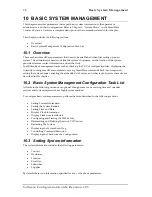
IP Context Overview
87
•
Finally if your network shall provide better service to selected network traffic, Chapter 15,
“Link Scheduler Configuration” will help you with getting in-depth knowledge about
quality of service (QoS) management with SmartWare.
The basic tasks involved in IP context configuration are described in the following sections. Many
parameters have acceptable default values, which in most cases do not need to be explicitly
configured. Hence not all of the configuration tasks below are required. Depending on your
application scenario, some tasks are mandatory or might be optional. The following tasks set up on a
bottom-up approach, starting from the ports, followed by the interfaces up to the services running on
the SmartNode, as shown in Figure 11-1. The first tasks below shall help you obtaining the necessary
overview, in view of the fact that there is always a risk getting lost in details before gaining a general
understanding of the whole network.
•
Planning your IP Configuration
•
Configuring Ethernet and Serial Ports
•
Creating and Configuring IP Interfaces
•
Configuring NAPT
•
Configuring Static IP Routing
•
Configuring RIP
•
Configuring Access Control Lists
•
Configuring Quality of Service
11.3 Planning your IP Configuration
Network connection considerations are provided for several types of physical ports types in the
following subsections. Drawing a network overview diagram displaying all neighbouring IP nodes
and serial connected elements is recommended. Do not begin configuring the IP context until you
have completed the planning of your IP environment.
11.3.1 IP Interface Related Information
Setting up the basic IP connectivity for your SmartNode requires the following information:
•
IP addresses used for Ethernet LAN and WAN ports
•
IP Subnet mask used for Ethernet LAN and WAN ports
•
Length for Ethernet cables
•
IP addresses of central H.323 Gatekeeper
•
IP addresses of central PSTN Gateway for H.323 and ISoIP based calls
•
IP addresses of central TFTP Server used for configuration up- and download
11.3.2 Serial Interface Related Information
The SmartNode 2300 supports both the V.35 and X.21 standard for synchronous serial interfaces with
speeds up to 2 Mbit/s. Devices that communicate over a serial interface are divided into two classes:
•
Data terminal equipment (DTE): The device at the user end of the user-to-network interface.
The DTE connects to a data network via data DCE, and typically uses clocking signals
generated by the DCE.
•
Data communications equipment (DCE): The device at the network end of the user-to-
network interface. The DCE provides a physical connection to the network, forwards traffic,
and provides a clocking signal used to synchronize data transmission between DCE and
Software Configuration Guide, Revision 1.03
DTE devices.
Summary of Contents for SmartWare R2.00
Page 2: ......
















































